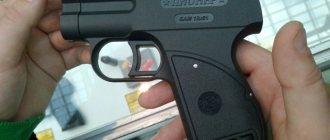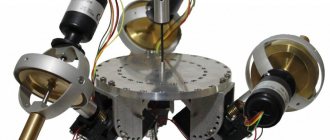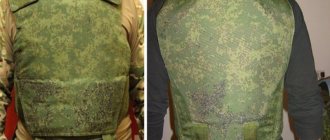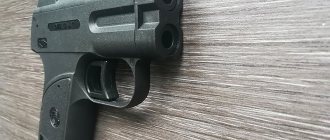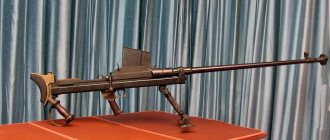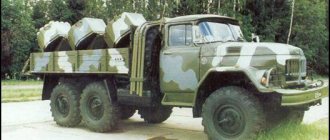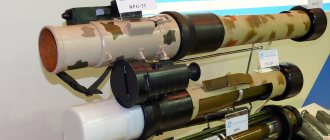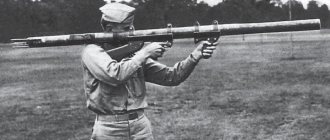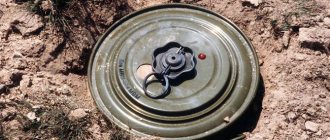Use of aerosols and fumes
Hand-held smoke grenades are designed to set up camouflage smoke screens in close combat by single soldiers and small units, as well as to camouflage exits, crews and various military equipment.
Black smoke grenades can also be used to simulate the burning of tanks, infantry fighting vehicles and self-propelled artillery units. There are four types of hand smoke grenades; RDG-P and RDG-2x with a metal-chloride mixture of white smoke, RDG-2ch with an anthracene mixture of black smoke. RDG-26 - white smoke.
Characteristics of hand smoke grenades
| Parameter | RDG-P | RDG-2x | RDG-2b | RDG-2ch |
| Weight, kg | 0,5 | 0.5-0,6 | 0,5-0,6 | 0.5-0.6 |
| Burn-up time, s | 3.5 | 15 | 15 | 15 |
| Duration of intense smoke formation, min | 1-2 | 1-1.5 | 1-1.5 | 1-1.5 |
| Length of invisible smoke screen, m | 35 | 25-35 | 20-25 | 10-15 |
Instructions for use
In order for the room to be processed safely, you must correctly follow the instructions for use of the product.
The estimated consumption of the product is 1 checker per 5-10 “cubes” of space. If the room is large, and several checkers are used to process it, they need to be placed and set on fire in such a sequence that the person moves in the direction of the exit.
Step-by-step instructions for use:
- Remove all items that can be removed from the area being treated. Be sure to remove food (including canned food) and plants.
- We treat metal surfaces with anti-corrosion agents. Sulfur dioxide released during combustion accelerates the corrosion of metals. To avoid this, you need to coat the metal surface with paint or coat it with grease.
- In the room being treated, all cracks and openings should be tightly closed: windows, ventilation ducts, any leaks. You also need to prepare in advance for sealing door cracks - you can use tape for this purpose.
- We place a pedestal on the floor (50-100 cm from flammable objects or substances) on which the checker will stand. For these purposes, you can use several bricks, forming a kind of “foundation”. It should be wide enough - approximately 30x30 cm. If the floor is wooden, you should use a metal basin instead of a brick pedestal.
- We place the checker on the “foundation” and remove the protective film.
- Insert a wick into the checker and light it with matches/lighter.
- Wait for a small amount of smoke to appear and leave the room immediately. The wick burns (smolders) for a little longer than 30 seconds.
- We close the front door and seal all the cracks on the outside.
The combustion process itself takes from half an hour to 80 minutes (depending on the humidity in the room).
You cannot enter the premises for 36-48 hours; this time is just enough for processing. After this period, the room must be ventilated for two days. If this is not enough (the smell of sulfur is felt), we extend the ventilation for another 1-2 days.
Example of greenhouse processing (video)
Safety precautions for use
During the manufacturing process (production) or storage at home, the checker is not dangerous (neither for humans, nor for animals, nor for plants), and belongs to the fourth hazard class (low-hazardous compound).
During the combustion process, the substance released belongs to the second hazard class. Therefore, you need to use personal protective equipment to process the premises:
- Respirator (ideally a gas mask).
- Latex gloves.
- You can use a protective apron or boots - but this is not necessary, as long as you have just a change of clothes (not used anywhere in everyday life).
Please note: gauze bandages, homemade respirators with cotton wool filters - all this will not protect against the combustion of sulfur and the formation of sulfur dioxide. In this case, only professional personal protective equipment has protective functions.
Ideally, the work should be done by two people. Both people can lay out checkers, seal cracks and close holes. After which one leaves the room, and the second sets it on fire. The first one in this case plays the role of a belayer - in case of danger, he helps the one who sets the fire to get out. Therefore, both need to use protective equipment.
Smoldering Checker
After treating the room, wash your clothes thoroughly, change the filters on your respirator or gas mask, and take a shower (be sure to use soap). It is advisable to rinse your mouth (immediately after treatment) and drip a saline solution into your nose (for rinsing).
Call an ambulance immediately if the following symptoms occur (during treatment, when you left the premises, or after it):
- headache and/or dizziness;
- attacks of nausea, vomiting;
- pain in the chest, shortness of breath;
- nose bleed;
- difficulty breathing (inability to inhale or exhale normally), wheezing, cough without relief.
Such symptoms indicate poisoning by combustion products. Delayed medical care can lead to serious consequences and even death.
How to properly use a checker for processing greenhouses: detailed instructions
Effective ways to combat mold (fungus) in the bathroom
Related Posts
Smoke bombs
Small smoke bombs DM-11, ShD-MM are designed for setting up camouflage smoke screens manually. To operate the DM-11 and DMX-5, it is necessary to pierce holes in
specially designated places and insert the fuse, quickly run a grater along the head of the fuse at arm's length and move away from it 25 m.
The UDSH unified smoke bomb is intended for setting up masking smoke screens manually, as well as using mechanized means (PMZ-1.1 minelayer
helicopter mine spreader VMR-1) and remote control of the smoke exhaust. It is manufactured in a housing whose dimensions correspond to the body of the TM-62 anti-tank mine. In the central part!
The checkers contain an igniting composition and an igniter device, which ensures that the checkers are ignited manually by impact, by the action of a pressure mechanism, or by applying an electric |
pulse from an external current source. During the burning of a saber, personnel should not be closer than 25 m. The saber is equipped with a metal-chloride mixture
Large smoke bombs БДШ-5 and БДШ-15 are designed for setting up camouflage smoke screens, including on water, manually, as well as using remote means!
smoke exhaust controls They are a metal case filled with an anthracene mixture and are activated by impact or with the help of an electrical impulse from
external current source. While the bomb is burning, personnel should not be closer than 25 m.
Characteristics of smoke bombs
| Parameter | DM 11 | ShD-B | SHCHD MM | UDS | BDSh 5 | BDSh 15 |
| Weight, kg | 2.2-2.4 | 23.4 | 3 | 13.5 | 45-50 | 45-50 |
| Burn-up time, s | 30 | 7-10 | up to 7 | 10/30 | 30 | 30 |
| Duration of intense smoke formation, min | 5-7 | 4-6 | 3-4.5 | 8-10 | 5-7 | 15-17 |
| Length of invisible smoke screen, m | up to 50 | 300 | 70-100 | 100-150 | 200 | 100-120 |
| Range of masking and protective action microns | 0.4-0.75 | 0.4-0.75 | 0.4-1.5 | 0.4-1.56 | 0.4-0.75 | 0.4-0.75 |
What is a sulfur bomb Fas: composition, weight
The main active ingredient is sulfur: the composition of the universal FAS checker consists of 80% of it. Product weight is 300 g (+- 5%). The outer skin of the product is made of polycarbonate. The shape can be cylindrical or triangular.
The product package includes a wick so that it can be lit. The wick is long enough so that after setting fire the user can leave the treated area in a timely manner.
The Fas checker looks similar to a military smoke grenade (the casing of which is also made of carbonate), and the principle of its use is exactly the same. Therefore, when transporting a product to a dacha through traffic police checkpoints, problems may arise with explaining its purpose.
Where is it sold and how much does it cost?
You can purchase the Fas checker in stores specializing in pest control products. Sometimes it is sold in flower shops and home improvement stores. You need to look for it in the insect control department.
Checker Fas and its packaging
The average cost is 50-70 rubles.
Purpose: where and for what can the Fas smoke bomb be used?
The main purpose is to destroy fungal microorganisms (mold), remove small rodents (for example, it can be used against mice) and fight insects.
The product is not intended for treatment of residential premises . It can only be used in non-residential premises: basements, greenhouses, hotbeds, as well as in outbuildings after relocating pets from them.
Basements must be treated before storing food. Processing of greenhouses is carried out after harvesting, before the next planting.
The Fas checker should be used in the following cases:
- For disinfection purposes. The product is used to destroy mold microorganisms and some types of bacteria. You can use the product in the cellar and in the greenhouse to combat mold. This method is quite effective: smoke easily penetrates into all corners, neutralizing mold deposits.
- For disinfestation purposes. The product is perfect for killing insects (cockroaches, ants, bedbugs, etc.).
- For breeding small animals (moles, mice, rats). The saber simply drives away the most persistent rodents, and kills the weaker ones, paralyzing the nervous system.
- To combat unwanted vegetation (for example, moss).
Is the Fas checker dangerous for humans, crops, and plants?
The manufacturer assures that the smoke from the bomb does not affect the human body (when wearing a respirator or gas mask), and if it does, it is minimal. In fact, inhaling sulfur dioxide is dangerous, so when using the product you should definitely use protective equipment and leave the room as soon as possible after setting it on fire.
There is a potential risk to human health. The hazard class of the product during combustion is second (dangerous compounds). It is not recommended to stay in the treated area for a long time, even in PPE (personal protective equipment).
Instructions on the package
The effect of smoke on the body of animals is fatal - therefore, they (if we are talking about pets) must be removed from the room being treated, as serious disruptions to the functioning of internal organs are possible. It's all about the sulfur contained in the product: when it burns, it releases dangerous sulfur dioxide.
Smoke from a bomb can negatively affect various foods and plants (from potatoes to flowers). All products (even canned ones) must be removed from the area being treated.
What is it used for?
These are not the only cases, but before the First World War, smoke was not a full-fledged weapon. The clouds of smoke dissipated after the invention of smokeless gunpowder, and already in 1890, large countries abandoned the use of obsolete gunpowder.
Smoke returned to the position with the appearance of chemical weapons. For example, when releasing chlorine on the enemy, the Germans discovered that a fog formed around the cylinders, which could be used to identify their location. For camouflage they used safe smoke, which did not even interfere with the offensive. At the same time, they began to use screens to conduct retreats and accompany tank attacks.
Different armies used different mixtures and compositions of smoke. Using the example of 1914-18:
the British and French used phosphorus; Germans, a solution of sulfuric anhydride in sulfuric or chlorosulfonic acid, or the anhydride itself; The Russians fought with Ershov's sabers and similar means that produced solid particles. The smoke was white; The Americans installed curtains made from a mixture of zinc dust and carbon tetrachloride.
Initially, black products were used, but they did not provide reliable camouflage. The first white smoke was released by the Germans.
Checker with colored smoke
In addition to camouflage purposes, smoke served signaling functions. It has long been used to warn about a threat. They also managed to use it as an analogue of Morse code, releasing puffs of smoke at a certain interval.
In modern conditions, manual versions are common, for example, the Russian Army has RDG-2, RDG-2x and RDG-2ch. They allow you to perform the following tasks:
creation of a short-term screen for advance/retreat, used over a small area; allows you to disorient or blind enemy units; simulate activity, fire, including damage to equipment at a certain point; mining/clearing; during evacuation from the battlefield; allows you to indicate your location for aviation during search operations; send a certain signal, a coded message, for which colored smoke or a trigger of a certain duration can be used.
During World War II, the combat use of chemical smoke agents was abandoned because it became possible to protect the army, but the fear of large-scale use remained. Poisons migrated from the trenches to the concentration camps.
Currently, chemical weapons are banned by the UN, so their use is limited to the listed functions of the RDG. However, this does not completely exclude the possibility of dying from such weapons.
History of creation
In the last decades of the 19th century, gunpowder guns and cannons created a dense cloud of smoke over positions. Such a veil could play into the hands of both sides of the conflict:
block soldiers from view; allow you to maneuver unnoticed; interfered with one’s own view at high density; may have misled reserves; commanders could completely lose sight of their troops, which excluded any coordination.
There is documentary evidence of the use of such a tool from earlier periods. The black tribes of South Africa prevented their opponents from taking aim with a bow and throwing spears accurately, for which they used torches impregnated with resin. When burned, such an instrument produced thick yellow smoke.
Smoke bombs in modern combat conditions
In 1701, when crossing the Western Dvina, the Swedes deceived the Polish-Saxon troops. This was done by setting fire to the straw near the crossing, which was covered in thick smoke.
Varieties of smoke fumes
Even on the battlefields of the First World War, smoke from burning straw/leaves was often used. However, later army smoke bombs and other options appeared:
When fuel burned, fine solid particles appeared (straw also burns according to this principle); Instead of solid elements, a curtain of liquid droplets suspended in the air was created; Modern formulations can be of both types, but smoke-forming liquids are the most common.
It quickly became clear that the resulting smoke needed to be evaluated based on parameters such as stability and density.
RDG. The letters indicate the color of the smoke
Now there is a wide range of smoke makers for setting up smoke screens, signaling functions, attack, defensive and entertainment purposes. Two main groups can be clearly distinguished:
Military means; Civilian.
Obviously, the former are only available to military personnel, and often require the use of appropriate weapons to launch. Among such means are UDSH, BDSH.
Pyrotechnic and colorful
Colored smoke bombs and signal smokes are placed using smoke bombs of the appropriate type. In the classic, white design, checkers produce light smoke, which can vary in density and stability, depending on the type of pyrotechnic agent used.
Special purpose or military
Hand grenades are part of a fighter’s equipment and they have proven themselves best in urban combat and on rough terrain.
For under-barrel grenade launchers and curtain installation systems on vehicles, they use their own ammunition/shells.
RDG
Chemical grenades, which the Russians were among the first to use on the battlefield of World War I, are designed to create an impenetrable or poisonous curtain. This method effectively suppressed firing positions, since staying in the cloud for more than 15 minutes caused death.

